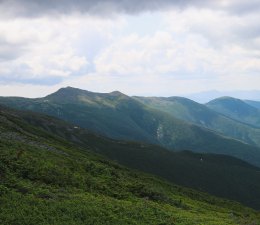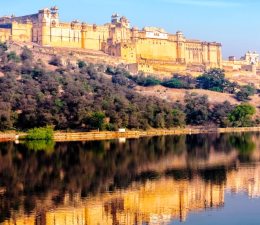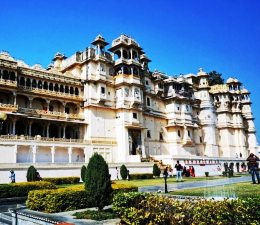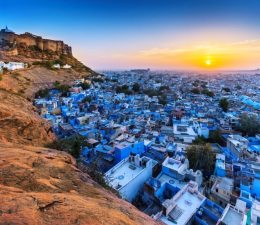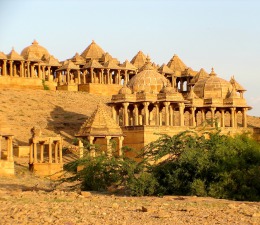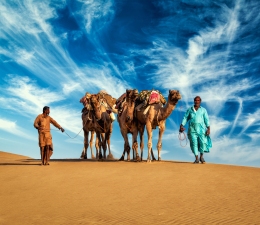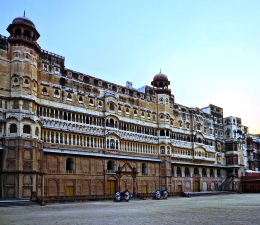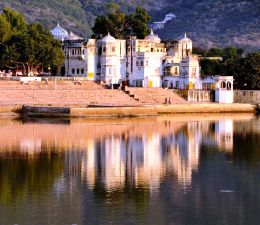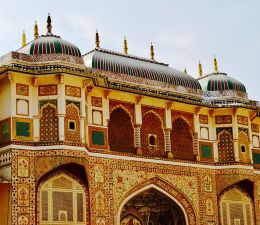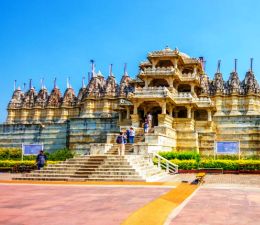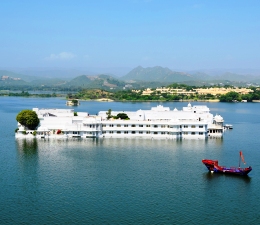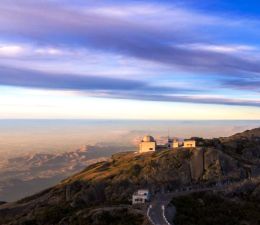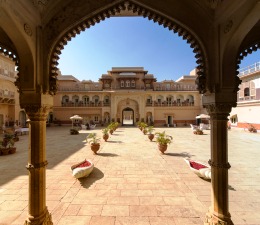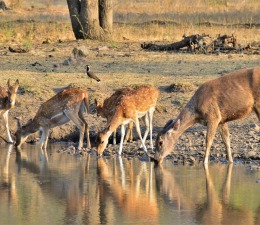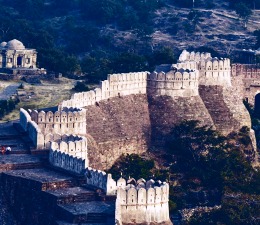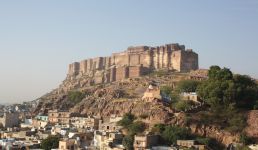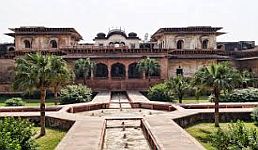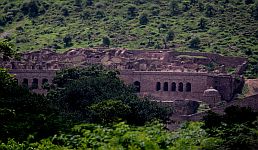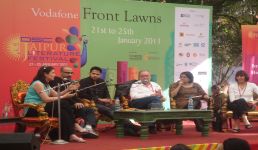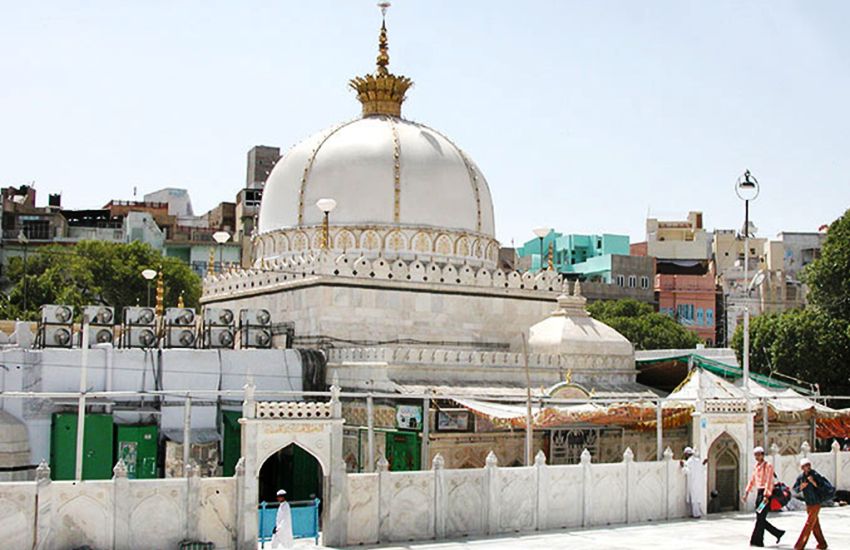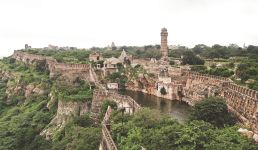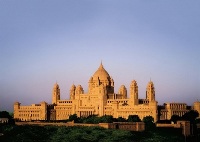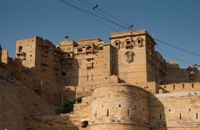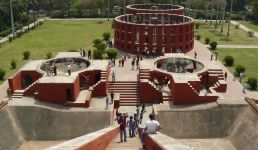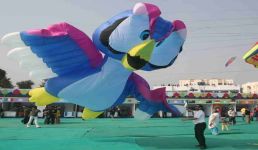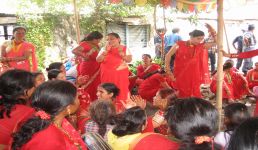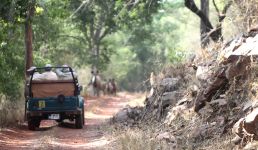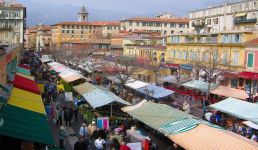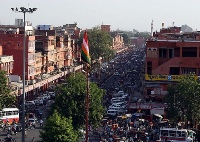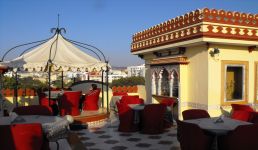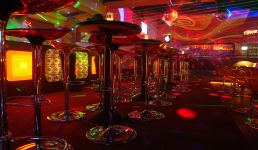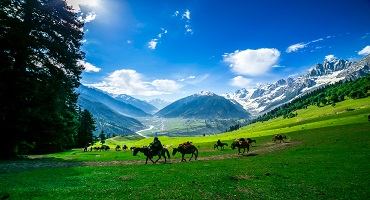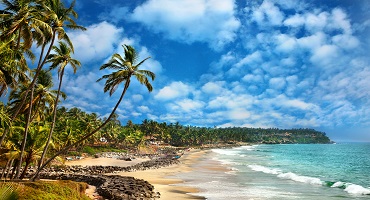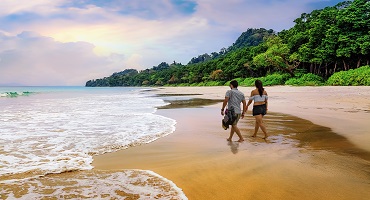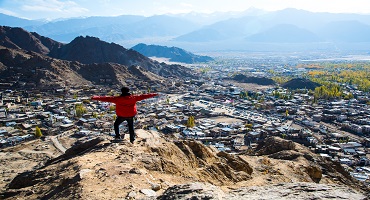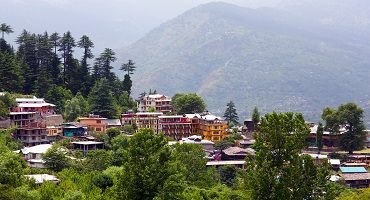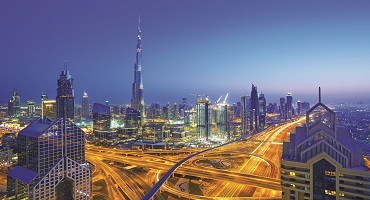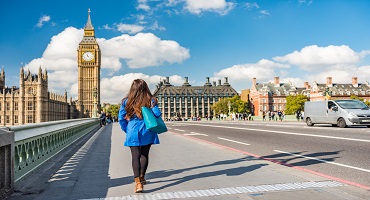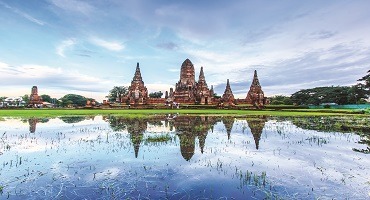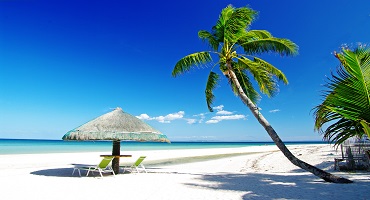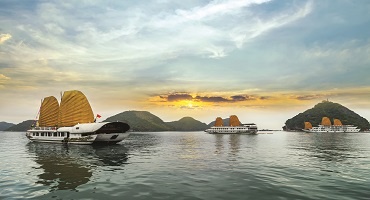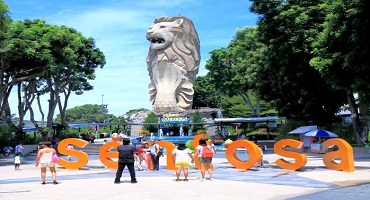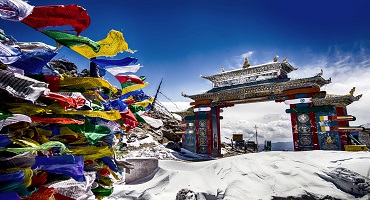Rajasthan is a state located in the northwestern region of India. It is a land full of rich cultural and historical heritage. It is considered one of the best places for a memorable family vacation in the country. From unique regional traditions, vast deserts and lush greenery to historic forts, beautiful royal palaces and prominent religious landmarks, the state has a lot to offer in terms of tourism. It is also one of the most romantic places in the country where you can have a royal honeymoon with your significant other.
There are numerous royal palaces and forts spread across the state, like the Chittorgarh Fort, Jaisalmer Fort, Amber Palace, Umaid Bhawan Palace, etc. Besides that, religious landmarks in Rajasthan, like the Birla Mandir, Karni Mata Temple, Ajmer Sharif, etc., are also some of its main tourist attractions.
Rajasthan is a great holiday destination for adventure tourism and offers several fun activities, like zorbing, desert safaris, ATV riding, dune bashing and so on. Shopping for regional handicrafts is another thing tourists find interesting during their Rajasthan trip. Munching on delicious Rajasthani cuisine amidst a royal setting of a luxurious hotel is a phenomenal experience that the land offers. In addition, the availability of unique and fun entertainment options makes Rajasthan’s nightlife unparalleled.
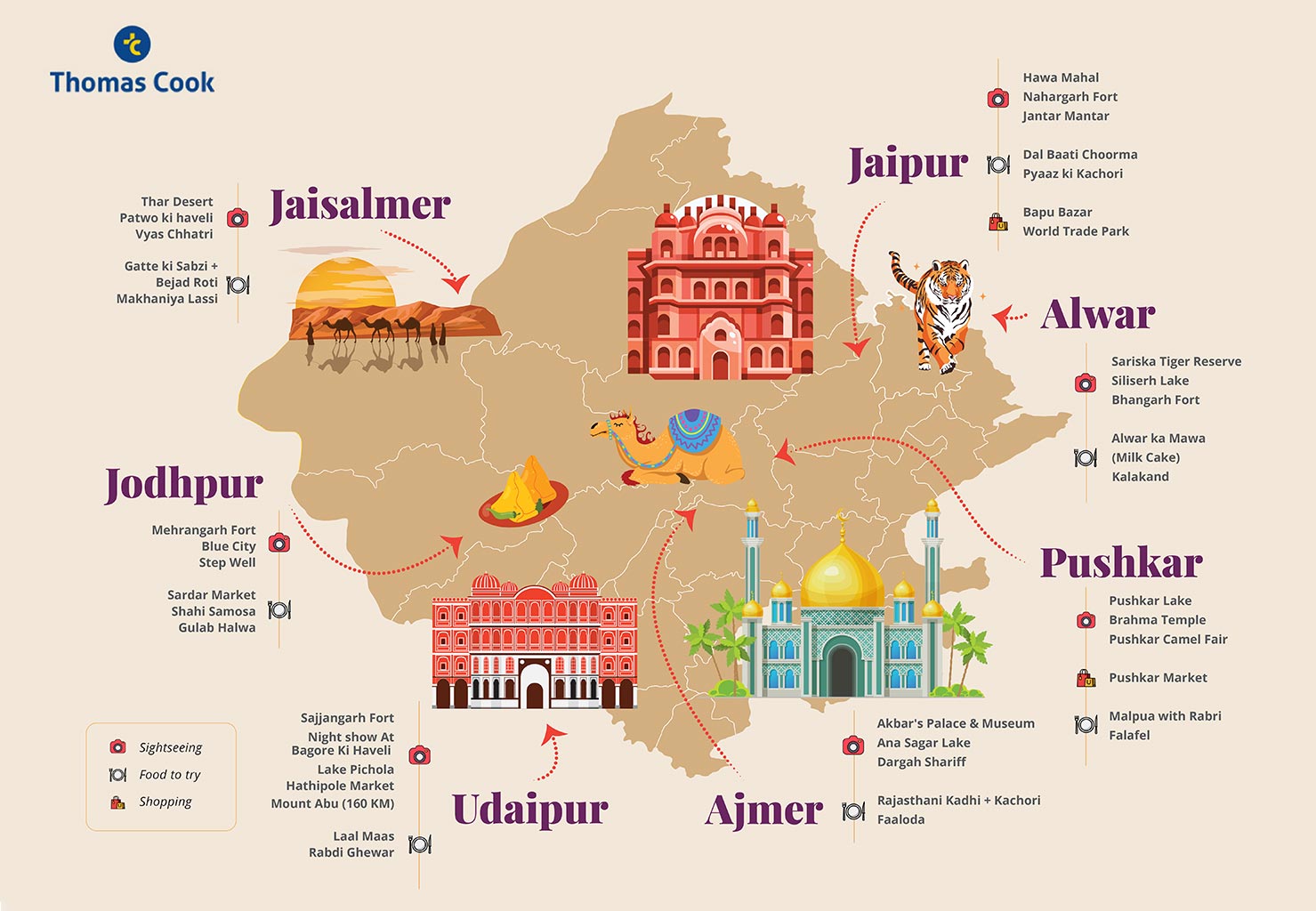
Attractions in Rajasthan
Tourist attractions in Rajasthan range from religious sites and historical landmarks to grand local festivals and cultural events. Here are some of the most famous Rajasthan tourist places and events that you can check out during your trip:
Jain Temple
The Ranakpur Jain Temple is one of the most visited Rajasthan tourist places. It is a prominent religious landmark in the region, known for its remarkable architecture. The temple was built in the 15th century and is dedicated to Rishabhanatha, the first Tirthankara of Jainism. Tourists can visit the temple between 12 PM to 5 PM.
Mehrangarh Fort
The magnificent Mehrangarh Fort sits on top of a hill in Jodhpur, about 122 metres above the surrounding land. It is one of the largest forts in the country and was constructed in 1459 by Rao Jodha, a Rajput ruler. Besides its distinct architecture, the fort is known for its seven gates (pol), temples, palaces and museum.
Sheesh Mahal
Sheesh Mahal, or the Mirror Palace, is inside the famous Amber Fort in Jaipur. It was built under the orders of Maharaja Man Singh in the 16th century and featured intricate works of glass, precious stones and hand-made paintings. It is one of the most interesting and beautiful Rajasthan tourist places that you can visit during your trip.
Ranthambore National Park
The Ranthambore National Park is one of the most visited Rajasthan tourist places for wildlife safaris. It covers an area of roughly 1,334 square kilometres and features distinct regional flora and fauna. Tourists can expect to see animals like tigers, deer, wild water buffalo, jungle cats, etc., at this national park. The Ranthambore Fort within the park is another famous tourist attraction.
Chittorgarh Fort
Chittorgarh Fort is among the top historical monuments in Rajasthan. It used to be the capital of Mewar and is now a UNESCO World Heritage Site. The fort, one of the largest in the country, covers several crucial historic structures, including palaces, temples, memorials, water bodies and victory towers. Located in Chittorgarh city, it is one of the must-visit Rajasthan tourist places.
Umaid Bhawan Palace
The Umaid Bhawan Palace is one of the most beautiful tourist places in Rajasthan that you can visit. Located in Jodhpur, the palace is named after Maharaja Umain Singh and is the residence of the royal family of Jodhpur. It features 347 rooms and is divided into three sections, a royal residency, a heritage hotel and a museum. The palace architecture and royal exhibits at the museum attract tons of tourists.
Hawa Mahal
The Hawa Mahal in Jaipur city is an iconic tourist attraction of Rajasthan. This pink and red sandstone-made structure was constructed under the orders of Maharaja Sawai Pratap Singh in 1799 so that royal women could comfortably witness the processions and the outside world from within the palace windows. Its remarkable architecture and unique interior draw massive tourist interest.
Bharatpur Bird Sanctuary
The Bharatpur Bird Sanctuary, now called Keoladeo National Park, is one of the best places to visit Rajasthan. This man-made wetland is a UNESCO World Heritage Site and home to over 360 unique bird species. You can expect to see birds like herons, cormorants, gadwall, Indian shag, wood sandpiper, etc., at this location.
Jaisalmer Fort
The Jaisalmer Fort in Rajasthan is one of the few “living forts” in the world. Also called “Sonar Quila”, this yellow sandstone-made fort was constructed in 1156 AD under the orders of Rawal Jaisal. The havelis, temples and gateways of the fort are its main attractions. The view of the Jaisalmer Fort from the city streets in the evening is a truly magnificent sight. It is among the most important historical monuments in Rajasthan.
Jantar Mantar
Located in Jaipur, Jantar Mantar is one of the unique Rajasthan tourist places that you can visit during your trip. It is an astronomical observation site built in the 18th century and has a collection of 19 instruments. Jantar Mantar was built by Maharaja Sawai Jai Singh II. It is a UNESCO World Heritage site and houses the largest stone-made sundial in the world, the Samrat Yantra.
International Kite Festival
It is an annual festival celebrated during the time of Makar Sankranti. The International kite festival in Rajasthan takes place in Jaipur city and is attended by thousands of domestic and international tourists. During this festival, the sky gets filled with colourful and uniquely-designed kites. Friendly kite wars and delicious food are the two main features of this festival.
Urs Festival
The Urs Festival is a major tourist attraction in Rajasthan. It is an annual festival that commemorates the death anniversary of Sufi Saint Moinuddin Chishti. This 6-day-long festival takes place in Ajmer and features night-long qawwali singing and dhikr chanting. During this time, thousands of devotees visit the Ajmer Sharif shrine to pay their respects.
Teej
Teej is one of the most important festivals celebrated in Rajasthan. It is mainly observed by women who celebrate the reunion of Goddess Parvati and Lord Shiva. The festival is marked by fairs, dance performances, religious chants, etc. The grand celebration of the Teej festival in Jaipur is marked by a procession featuring horses, elephants and camels.
Braj Holi
Braj Holi is a grand festival observed a couple of days prior to the main Holi festival. It is dedicated to the Hindu deity, Lord Krishna, and celebrates eternal love. The festival is marked by colourful splashes of Gulal, traditional attires, folk dance and music, regional delicacies, a reenactment of Rasleela, grand merrymaking, and so on.
Jaipur Literature Festival
It is an annual event held in Jaipur city and draws in visitors from all over the world. The Jaipur literature festival celebrates literature and works as a junction where world-renowned writers and authors meet. Many tourists attend this event to listen to the keynote addresses by prominent figures, including politicians and business tycoons.
Ajmer Dargah
The Ajmer Sharif Dargah is one of the most significant religious monuments in Rajasthan. It is the tomb of the Sufi saint, Moinuddin Chisthi, located about 2 kilometres from the centre of Ajmer city. It is a significant religious site in the region, visited by people of all faiths. The shrine was built by Emperor Humayun and is a great example of Mughal architecture.
Bhangarh Fort
The Bhangarh fort is one of the most popular historical places in Rajasthan. It is a 17th-century, stone and brick-built fort used as the residence of Madho Singh. Apart from the magnificent architecture, the fort features several ruins of marketplaces, temples, palaces, etc., within its premises. It is surrounded by lush greenery, offering irresistible scenic views to visitors. The Bhangarh Fort is also known as one of the most haunted places in India and attracts thousands of tourists around the year.
Neemrana Fort
The Neemrana Fort Palace is one of the most sought-after Rajasthan tourist places. Surrounded by dense greenery, this ancient structure offers magnificent views to its visitors. Located in Neemrana town in the Alwar district, the fort palace was converted into a luxurious hotel, featuring 74 rooms, spas, swimming pools, roof-top gardens, etc. It is also one of the best places to visit in Rajasthan for adventure activities.
Deeg Palace
The Deeg Palace was constructed in the 18th century and is located in Deeg town, about 35 kilometres from Bharatpur. It served as a luxurious summer resort for the Bharatpur State’s rulers. The palace is known for its splendid architecture and features beautiful fountains, massive pools and unique plants. A fort was later built around the palace to protect it from attackers. Deeg Palace is one of the best Rajasthan tourist places for a historical tour.
Activities in Rajasthan
Rajasthan has a plethora of fun adventures and exhilarating activities that it offers to tourists. Some of the most fun things to do in Rajasthan include:
Ziplining
Ziplining in Rajasthan is a fast-paced, fun activity you can try during your holidays in Rajasthan. Doing it at rushing speeds while soaking in the majestic scenic views of nature and historical monuments is an incredible experience. Mehrangarh Fort and Neemrana Fort Palace are some of the best places to visit in Rajasthan for ziplining adventures.
Jungle Safari
Jungle safaris in Rajasthan are a great way to explore its unique flora and fauna. It allows tourists to get close to nature and witness various plants and wild animals. Some of the best places to visit in Rajasthan for jungle safaris are Sariska Tiger Reserve, Ranthambore National Park and Bharatpur Bird Sanctuary.
Hot Air Ballooning
Flying in a hot-air balloon is a childhood dream for many, and Rajasthan is one of the best places in India to try this activity. Hot air ballooning in Rajasthan is a thrilling adventure and a brilliant way to explore the alluring landscape of the region. Pushkar and Jaipur are some of the best places to visit in Rajasthan for hot-air ballooning.
Desert Camping
Desert camping in Rajasthan is another popular adventure that you can consider. You can spend the mornings in beautiful tents and enjoy the starry nights amidst the vast desert terrain. There are also various entertainment options, like puppet shows, folk dance and music, etc., at these camping sites. The best places to visit in Rajasthan for desert camping are Jaisalmer and Jodhpur.
Vintage Car Rally
Car enthusiasts looking for fun things to do in Rajasthan can go for the Vintage Car Rally experience. It is a very entertaining show that takes place in Jaipur city, and you can expect to see vintage cars like the 1936 Mercedes Benz 170V, 1923 Fiat 501, etc.
Witness the Abhaneri Step Well
The Abhaneri step well is one of the most famous historical places in Rajasthan. It is considered an architectural wonder and was featured in various movies. Witnessing this brilliant site and taking pictures at this location are fun things you can try during your Rajasthan holidays.
Trekking
Trekking in Rajasthan is a fun activity that you can try. Remarkable natural landscapes and challenging routes make it a prominent place for this activity. The Aravalli range passing through the state attracts tons of trekking enthusiasts. It is one of the world’s oldest mountain ranges and offers some of the best panoramic views of the region.
Dune Bashing
Dune Bashing is a signature desert adventure that tourists can try in Rajasthan. It involves driving over sand dunes in a specialised 4x4 vehicle at alternating speeds. Jaisalmer is one of the best places to visit in Rajasthan for dune-bashing activities.
Camel Safari
For an authentic desert adventure experience, tourists can opt for camel safaris. It is a great way to explore the magnificent desert terrain in the region and is suitable for most people. Jaisalmer is one of the best places to visit in Rajasthan for camel safari.
Motor Boating
Motorboating is a popular adventure attraction in Rajasthan. Breezing through the water at thrilling speeds while enjoying the scenic beauty is a remarkable experience tourists can go for. The Fateh Sagar Lake in Udaipur is considered the best place for motor boating in Rajasthan.
Horse Safari
Horse safaris in Rajasthan allow tourists to explore the beautiful cities and their prominent attractions in a fun way. It is a safe activity and is suitable for most individuals. One of the best places to visit in Rajasthan for horse safaris is Pushkar.
Visit the haunted house of Rajasthan
Thrillseekers can visit and explore the mysteries behind one of the most haunted places in India, the Bhangarh Fort. It can offer a unique and spine-tingling experience to the ones with a heart of steel. Visitors are not allowed inside the fort after sunset, so exploration is only limited to daytime.
Shopping in Rajasthan
From beautiful traditional dresses and intricate handicrafts to contemporary accessories and local delicacies, shopping in Rajasthan is a royal experience in itself. Here are some of the best places in Rajasthan for shopping:
Johari Bazaar
It is the most famous marketplace in Jaipur city. There are hundreds of local shops in the area, selling all kinds of traditional goods made by local artists. The Johari Bazaar is one of the best places to visit in Rajasthan to shop for beautifully designed Rajasthani jewellery. Other products sold in this market include sarees, handbags, gemstones, food, traditional lehengas, etc.
Bapu Bazar
Bapu Bazar is another prominent shopping location in Jaipur that tourists can visit. It is located within walking distance of Johari Bazaar and is known for offering high-quality regional goods at attractive prices. Popular items that tourists buy at this location include Jaipuri juttis, leather bags, Lac bangles, and ethnic jewellery.
Clock Tower Market
The clock tower market is located next to the famous Ghanta Ghar. It is a go-to shopping location for both locals and tourists in the city. The market features several stores and street vendors selling local handicrafts, apparel, souvenirs, food, etc.
Nai Sarak
For the best shopping experience in Jodhpur, make sure to visit Nai Sarak. It is one of the best places in Rajasthan where you can shop for high-quality Bandhani clothes. The products sold at this market are affordable and perfect examples of authentic Rajasthani speciality works. Other popular must-buy items at this market include leather goods and colourful turbans.
Bada Bazar
Bada Bazar in Udaipur is one of the most well-rounded markets in Rajasthan. There are multiple shops in the market area, selling all kinds of goods to locals and tourists, like clothing, gold jewellery, silverware, leather products, gemstones, souvenirs, etc. It is a great place to shop within all budget ranges. Tourists can visit the market between 9:30 AM to 8:00 PM.
Food in Rajasthan
Delicious cuisine and luxurious restaurants make dining in Rajasthan a fantastic experience. Here are some of the best dishes and restaurants that tourists can try:
Restaurants in Rajasthan
Bundi Vilas
It is a popular rooftop restaurant in Bundi, known for offering panoramic views of the fort and the town. Its elegant decor and mesmerising setting are ideal for romantic dinner dates in Rajasthan. It is vegetarian-friendly, serves delicious Rajasthani dishes and is quite affordable. Make sure to give the dessert menu a try when visiting this restaurant.
Peacock Rooftop Restaurant
It is one of the best restaurants in Jaipur. Located at Hotel Pearl Palace, the Peacock Rooftop Restaurant offers a beautiful dining ambience and a multi-cuisine menu. It is known for its exceptional service and variety of delicious dishes. The mocktails at this restaurant are quite popular.
Ambrai
Located at Amet Haveli, Ambrai is one of the most beautiful lakeside restaurants in Udaipur. You can enjoy the mesmerising view of Lake Pichola, Jag Mandir, and City Palace while grabbing a bite at Ambrai. It serves a variety of cuisines, including Indian, Continental and Chinese. Some of its must-try dishes are Ambrai ke Falafel, Govind Gatta Curry and Tandoori Aloo Nazakat.
Indique
It is a famous rooftop restaurant at Pal Haveli Hotel in Jodhpur. It offers 360 views of the city and its famous attractions, like Mehrangarh, Clock Tower, Umaid Bhawan, etc., which add to the dining experience. The main highlight of Indique restaurant is its wide range of delectable Rajasthani dishes, beverages and desserts.
Saffron
The Saffron is a go-to place in Jaisalmer for delicious Rajasthani lunch and dinner. It has spacious roof-top seating and offers vegetarian-friendly options. It is a great place to have a family dinner in the city. Some of their must-try dishes are Veg Pulao, Laal Maas and Rasmalai.
LMB
Laxmi Misthan Bhandar, or LMB, is a great place to eat in Jaipur. It features comfortable seating and a cosy ambience. It is within a few minutes walk from Johari Bazaar and is known for its authentic vegetarian dishes and mouth-watering desserts. Some of their must-try items are Rajasthani Thaali, Kala Jamun and Dahi Vada.
Little Italy
If you are looking for delicious Italian food in Rajasthan, consider visiting Little Italy. It is a well-known restaurant located in KK Square, Jaipur. The place is known for its hospitable service and contemporary setting. Some famous dishes to try at Little Italy are Risotto, Ravioli, Pasta and Lasagna.
Sankalp
Sankalp Restaurant is a well-known place in Mount Abu where you can find tasty food at affordable prices. It is a great place to go for both lunch and dinner. The consistency of food quality and service at this place has won the heart of many customers. Some of their popular dishes are Masala Papad, Dosa and Uttapam.
Out of Blue
Located in Pushkar, this restaurant features an elegant atmosphere, a beautiful view and a multi-cuisine menu. It remains open from 8 AM to 11 PM and is a pocket-friendly place to satisfy your hunger in the city. The food served at Out of Blue both looks and tastes phenomenal. Some of their must-items include Pasta, Pizza, Falafel and Coffee.
Sixth Sense
It is one of the most exquisite locations in Pushkar to go for a meal. The traditional setting, prompt service and flavoursome food at this restaurant make it a perfect place to have a romantic dinner in the city. When visiting the Sixth Sense, consider trying the Thalis and smoothies they offer.
Dishes in Rajasthan
Laal Maas
It is one of the most popular Rajasthani dishes that you can try during your visit. Laal Maas is a spicy, non-vegetarian dish made with lamb meat, red chillies, onions, coriander seeds, garlic, and some other ingredients. It has a signature red colour and offers a burst of flavour with every bite.
Mawa Kachori
It is a mouthwatering vegetarian delight available across Rajasthan. It is a type of sweet kachori made with flour, mawa, sugar, saffron, pistachio, almonds and ghee. It is then drenched in sugary syrup and served hot. Mawa Kachori is an ideal part of a Rajasthani breakfast.
Gatte ka Pulao
Gatte ka Pulao is made with steamed basmati rice, gatte, cardamom, turmeric powder, cloves, and some other ingredients. It is then garnished with chopped coriander and served with Kadhi. It is a flavourful dish Rajasthani dish that you can try.
Nightlife in Rajasthan
The nightlife in Rajasthan is blessed with an enormous range of entertainment options. Here are some popular things you can consider:
Light and Sound Shows
At night, various prominent places host beautiful light and sound shows in Rajasthan. They are usually an hour-long exuberant display of lightwork and traditional folk music and tell various historical stories of the region. These shows attract tons of tourists and are a great form of entertainment in the city. The light and sound show at Udaipur City Palace and Jaipur Amer Fort are the most famous ones.
Music and Dance Shows
Attending music and dance shows in Rajasthan is a great way to spend a memorable evening. At these shows, you can witness an exemplary display of regional dances, like the Ghoomar dance, Kacchi Ghodi, Fire Dance, etc., along with rhythmic folk music. Some of the best places in Rajasthan where you can attend evening music and dance shows are Jawahar Kala Kendra and Birl Auditorium.
Puppet Shows
Traditional puppet shows in Rajasthan are an important part of the region’s culture. At these shows, colourful puppets and traditional music are used as a narrative medium to illustrate parts of Rajasthan’s history. Rajasthan’s puppet shows are famous around the globe and are a great source of entertainment. The Rupayan Sansthan in Jodhpur and Bharatiya Lok Kala Mandir in Udaipur are two of the best places for puppet shows in Rajasthan.
Bhang Shop
Located in Jaisalmer, the Bhang Shop in Rajasthan is a well-known place you can visit during the evening. It is a simple shop that sells a wide range of products, like lassi, cakes, cookies, etc., made from Bhang. It is a mixture of cannabis leaves, milk, ghee and a few spices. It can offer a unique experience that you can enjoy during your visit.
Blackout
The Blackout Club is one of the most famous places you can visit to experience the vibrant nightlife in Jaipur. It is known for its brilliant rooftop view, upbeat DJ music and a joyful party ambience. You can enjoy a delightful evening with your loved one at the rooftop bar or groove to the music on the spacious dance floor.


